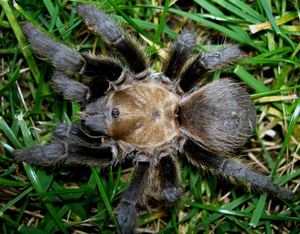Scientific Fact About Tarantulas #1: The ‘real’ tarantula is a wolf spider.
Many regions of the world have given nicknames to these hairy spiders known by their scientific name Theraphosidae (ther-uh-FO-suh-dee). North America lays claim to the nickname tarantula which seems to have stuck. In Africa they are called baboon or monkey spiders. The nickname bird spider comes from South America.
The spider whose scientific name inspired the nickname tarantula is actually a wolf spider and not a tarantula. Lycosa tarentula is found in southern Europe.
Scientific Fact About Tarantulas #2: The fangs are connected to the chelicerae.
Tarantulas are invertebrates, meaning they have no backbones. They wear their exoskeleton on the outside of their bodies like other invertebrates such as ants. For this reason it is not easy to sing Dry Bones to name the parts of a tarantula.
Look closely at a tarantula and you will see more than just legs and fangs. Tarantulas have eight legs and two pedipalps that are located at the front of a tarantula and resemble legs. They have two fangs which are at the end of the chelicerae.
Tarantulas have eight eyes on top of the cephalothorax. The pedicel connects the front half of the spider, the cephalothorax, to the back of the tarantula, the abdomen. At the very back of the tarantula you will see spinnerets that are used to spin the tarantula’s web.
Scientific Fact About Tarantulas #3: Tarantulas can have bad hair days.
Tarantulas have thousands of tiny hairs called setae (SET-tee) that are a part of their exoskeleton. Just like people, tarantulas have different types of hair. Many of these hairs are used to sense vibrations which can tell the tarantula if lunch is nearby. Some of the hairs act like taste organs.
When you see a tarantula with a bald spot on their abdomen you can bet they are a species of tarantula that has urticating (er-ti-KATE-ing) hairs. Certain species of tarantulas have urticating hairs that they flick off as a defense mechanism when they are feeling threatened or disturbed. Urticating hairs have backwards pointing barbs and can irritate the skin, eyes, and nostrils of animals including people. There are four major types of urticating hairs and some species of tarantulas have more than one type of urticating setae.
Scientific Fact About Tarantulas #4: Tarantulas have versatile fangs.
Most spiders have fangs that only move from side to side. A tarantula’s fangs move both side to side to help get a firm grip on their prey, and up and down which helps pull their prey closer to their mouth. When a tarantula goes to bite something their fangs extend forward, otherwise their fangs rest against their chelicerae.
Scientific Fact About Tarantulas #5: Tarantulas are very old.
According to fossil records it is likely that spiders have been living on earth for at least 300 million years. The first tarantula-like animals lived with the dinosaurs and appeared during the Mesozoic era. There is a giant spider drawing in Peru that was created thousands of years ago.
Scientific Fact About Tarantulas #6: The truth about spider venom.
Almost all spiders have venom glands but the potency of the venom widely varies among spider species. Species of spiders, like tarantulas, who attack passive prey have a less powerful venom than species of spiders that attack bees, wasps, and other spiders.
According to Uncover Tarantula by David George Gordon, in the United States there has not been a single spider bite related death in decades in contrast to the over 200 deaths per year from ant, bee, and wasp stings.
In all my research I could not find a single documented death from a tarantula bite. If you are bitten by a tarantula the skin around the wound may become red and swollen. Rarely an allergic reaction may cause fever, dizziness, and shortness of breath. Many tarantula enthusiasts would rather be bitten by a tarantula than get a tarantula’s urticating hairs up their nose.
Scientific Fact About Tarantulas #7: Tarantula venom could save your life.
A protein found in the venom of a common pet spider, the Chilean rose tarantula, is currently being studied for its potential to stop the human body from releasing harmful chemicals during a heart attack. This could be administered by paramedics and increase the likelihood of survival for a person suffering from a heart attack.
Sources:
Gordon, David George. Uncover Tarantula. San Diego, CA: Silver Dolphin Books, 2004.
Orkin. “Tarantula Spider Body Parts.” Orkin.
http://www.orkin.com/other/spiders/tarantula-spider-body-parts



